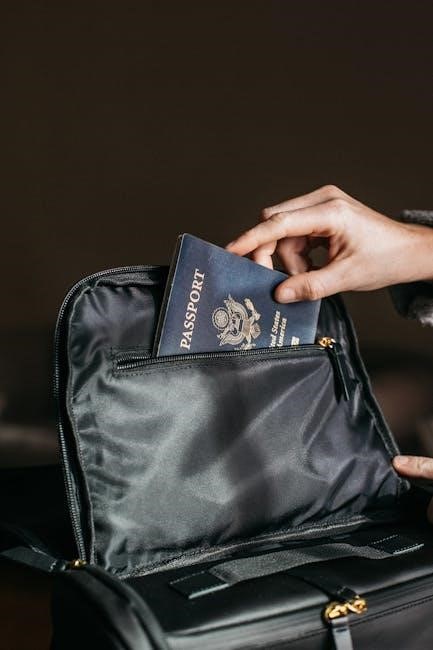Welcome to the guide on using Bard catheter bags effectively. Proper usage ensures comfort, hygiene, and functionality. Learn how to secure, empty, and maintain your catheter bag correctly for optimal results.
Overview of Bard Catheter Systems
Bard catheter systems are designed to provide reliable and comfortable urinary drainage solutions. These systems typically include a catheter, drainage bag, and connecting tubes. They are available in various sizes and types, such as Foley catheters, intermittent catheters, and external catheters, catering to different patient needs. Bard catheter systems are known for their high-quality materials, including latex and silicone options, ensuring durability and patient comfort. The systems often feature anti-kink tubing, secure connectors, and sterile packaging to minimize infection risks. They are suitable for both short-term and long-term use, offering flexibility for patients with varying conditions. Proper usage of Bard catheter systems ensures effective drainage, reduces the risk of complications, and enhances overall patient well-being. Always follow the manufacturer’s guidelines for optimal performance and safety.
Importance of Proper Catheter Bag Usage
Proper catheter bag usage is crucial for maintaining hygiene, preventing infections, and ensuring the overall effectiveness of the catheter system. Incorrect usage can lead to complications such as urinary tract infections (UTIs), skin irritation, or leakage. By following the correct procedures, patients can minimize the risk of these issues and enjoy a better quality of life. Proper usage also ensures the catheter bag functions as intended, providing reliable drainage and reducing the likelihood of blockages or kinks in the tubing. Adhering to the manufacturer’s guidelines helps maintain the integrity of the system and prevents potential breakdowns. Always prioritize proper techniques for connecting, securing, and emptying the catheter bag to ensure optimal performance and patient comfort.

Key Considerations Before Use
Ensure the catheter bag is sterile, compatible with your catheter, and suitable for your specific needs. Always follow manufacturer guidelines and consult a healthcare professional if unsure.

Understanding the Components of the Bard Catheter Bag
The Bard catheter bag consists of a collection chamber, drainage tube, and anti-reflux valve. The collection chamber holds urine, while the drainage tube connects to the catheter. The anti-reflux valve prevents backflow, ensuring urine flows only one way. Additional features may include a flip-flo valve for intermittent drainage and elastic straps for secure placement. Understanding each component is crucial for proper usage and maintenance. Always inspect the bag for any signs of damage or wear before use to ensure functionality and hygiene. Proper handling of these components will help prevent complications and maintain the system’s effectiveness.
Preparation Steps for Catheter Bag Setup

Before using the Bard catheter bag, ensure all components are ready. Begin by removing the protective cap from the drainage tube adapter. Gently attach the catheter to the adapter, ensuring a secure connection. Place the leg bag on the inside of your thigh, using elastic straps or supportive garments to keep it in place. Always position the bag below your waist to prevent urine backflow. If using a night drainage bag, connect it to the leg bag via the extension tube. Double-check all connections for tightness and inspect for any signs of damage. Wash your hands before handling the catheter system to maintain sterility. Proper preparation ensures a safe and effective experience with the Bard catheter bag.
Ensuring Sterility and Hygiene
Proper sterility and hygiene are crucial when handling the Bard catheter bag to prevent infections. Always wash your hands thoroughly with soap and water before touching the catheter system. Use sterile gloves if available to minimize the risk of contamination. Avoid touching the catheter tube or connectors with bare hands, as this can introduce bacteria. Clean the catheter insertion site daily with mild soap and warm water, and dry it completely to reduce bacterial growth. Regularly inspect the catheter and bag for visible signs of dirt or mold. Disinfect the bag and connectors with a recommended antiseptic solution, following the manufacturer’s guidelines. Maintaining a clean environment and following these steps will help ensure the longevity and safety of your catheter system.
Step-by-Step Instructions for Using the Bard Catheter Bag
Connect the catheter to the drainage bag securely, ensuring a tight seal. Position the leg bag below your waist to prevent backflow. Empty the bag regularly when it’s one-third full to maintain proper flow and hygiene. Always follow the manufacturer’s guidelines for a safe and effective experience.
Connecting the Catheter to the Drainage Bag
To connect the catheter to the drainage bag, first remove the protective cap from the catheter adapter. Align the adapter with the bag’s inlet port, ensuring a secure, leak-proof connection. Gently twist the adapter clockwise until it clicks into place. Make sure the catheter is positioned above the bag to prevent urine backflow. Double-check the connection for any signs of leakage by gently tugging on the catheter. If using a leg bag, secure it below your waist using elastic straps or supportive garments. Always follow the manufacturer’s guidelines for a proper and safe connection to maintain hygiene and prevent complications. Proper connection is crucial for effective drainage and comfort.
Securing the Leg Bag Properly
Securing the leg bag properly is essential for comfort and functionality. Place the leg bag on the inside of your thigh, ensuring it rests below your waist to prevent urine backflow. Use the elastic straps provided to fasten the bag securely, but not too tightly, to avoid discomfort or restriction of blood flow. Adjust the straps so the bag fits snugly against your leg. For added stability, consider using supportive garments like leg bag holders or compression shorts. Ensure the catheter tube is not kinked or twisted, as this can disrupt drainage. Properly securing the leg bag helps prevent leaks, ensures proper drainage, and enhances mobility. Always check the fit and placement regularly to maintain comfort and hygiene throughout the day.

Emptying and Cleaning the Catheter Bag
To empty the catheter bag, put on gloves and locate the drainage valve at the bottom. Open the valve and carefully pour the urine into a toilet or container. Avoid touching the valve to maintain sterility. After emptying, rinse the bag with warm water and mild soap. Use a clean, damp cloth to wipe the valve and surrounding area. Allow the bag to air dry to prevent bacterial growth. Regular cleaning helps maintain hygiene and prevents infections. Always wash your hands before and after handling the catheter bag. If using a leg bag, ensure it is emptied when one-third full to avoid overflow. Proper cleaning and drying are crucial for long-term use and comfort.
Maintenance and Care of the Catheter Bag
Regularly clean and disinfect the catheter bag to prevent infections. Check for signs of wear and tear, and replace the bag as needed. Proper storage and handling ensure longevity and functionality.
Regular Cleaning and Disinfection Practices
Regular cleaning and disinfection of the Bard catheter bag are crucial to prevent infections and maintain hygiene. After emptying, rinse the bag with mild soap and warm water. Avoid using harsh chemicals or abrasive materials that could damage the bag. For disinfection, mix a solution of equal parts white vinegar and water, and let it sit in the bag for about 10 minutes before rinsing thoroughly. Always rinse the bag with clean water after disinfecting. Allow the bag to air dry to prevent bacterial growth. Clean the bag at least once daily and after each emptying. Regular maintenance ensures the bag remains functional and hygienic for extended use.
Monitoring for Signs of Wear and Tear
Regularly inspect the Bard catheter bag for signs of wear and tear, such as cracks, tears, or discoloration. These issues can lead to leaks or bacterial growth, compromising the system’s effectiveness. Check the tubing for kinks, frays, or blockages, which can disrupt urine flow. Look for any loose connections or worn-out seals that may cause leakage. Inspect the bag’s material for softening or brittleness, which can indicate degradation over time. Perform these checks daily, especially after cleaning or emptying the bag. If you notice any damage, replace the affected part immediately to prevent complications. Regular monitoring ensures the catheter system remains functional and safe to use. Addressing wear and tear promptly helps maintain hygiene and prevents potential infections or system failures.
Replacing the Catheter Bag When Necessary
Replace the Bard catheter bag when signs of wear, such as cracks, leaks, or discoloration, are evident. This ensures optimal performance and prevents complications. Always use a new, sterile catheter bag to maintain hygiene. Before replacing, drain the old bag completely and disconnect it from the catheter tube. Follow the manufacturer’s instructions for securing the new bag to avoid leaks. Regular replacement, typically every 5-7 days, is recommended to prevent bacterial growth and maintain system integrity. If unsure about replacement procedures, consult a healthcare professional. Timely replacement helps prevent infections and ensures the catheter system functions effectively. Always prioritize sterility during the replacement process to safeguard your health and the longevity of the catheter system.
Troubleshooting Common Issues
Address common issues like leaks by checking connections. Resolve blockages by flushing the tube gently. Fix kinks by straightening the drainage tube carefully.
Addressing Leaks in the Catheter System
Leaks in the catheter system can be frustrating but are often easy to resolve. First, inspect the connections between the catheter and the drainage bag for tightness; Ensure the catheter is securely attached to the bag to prevent any gaps. If a leak persists, check for any visible cracks or damage to the tubing or connectors. Replace any damaged parts immediately. Additionally, ensure the leg bag is properly secured to your thigh to avoid shifting that might cause disconnections. For extra security, use adhesive strips or tape to reinforce the connection points. Regularly monitoring the system and addressing issues promptly can help prevent leaks and maintain proper function. Always follow the manufacturer’s guidelines for troubleshooting and replacement.

Resolving Blockages in the Catheter Tube
If you suspect a blockage in the catheter tube, act promptly to restore proper flow. Start by gently flushing the tube with sterile saline solution using a syringe, as recommended by medical guidelines. Ensure the syringe is specifically designed for catheter use to avoid damaging the tube. If the blockage persists, check for kinks or twists in the tubing and straighten it carefully. Avoid using harsh chemicals or force, as this could damage the catheter. If the issue remains unresolved, consult a healthcare professional for assistance. Regular maintenance, such as flushing the tube and ensuring proper positioning, can help prevent blockages. Always follow the manufacturer’s instructions for catheter care to maintain functionality and hygiene.
Fixing a Kinked Drainage Tube
A kinked drainage tube can impede urine flow, leading to discomfort and potential complications. To fix this, gently straighten the tube without forcing it, ensuring no twists or bends remain. If the kink persists, carefully inspect the entire length of the tube for additional kinks or blockages. Use your fingers to smooth out any bends, taking care not to stretch or damage the tubing. After straightening, check the flow by observing the drainage bag. To prevent future kinks, ensure the tube is securely fastened to your leg and avoid tight clothing or positions that may cause bending. If the issue recurs frequently, consult a healthcare professional for guidance or replacement if necessary. Regular checks can help maintain proper function and comfort.

Additional Tips for Comfort and Convenience

- Choose the right catheter bag size to ensure comfort and prevent leakage.
- Use supportive garments to keep the leg bag securely in place.
- When traveling, carry extra supplies and empty the bag regularly for convenience.
Choosing the Right Catheter Bag Size
Selecting the appropriate catheter bag size is crucial for comfort and functionality. Consider your activity level, mobility, and the duration you plan to use the bag. A bag that is too small may require frequent emptying, while one that is too large can be cumbersome. Measure your leg circumference to ensure a proper fit for leg bags. Consult your healthcare provider for recommendations tailored to your needs. Additionally, some catheter bags offer adjustable straps for a secure fit. Always prioritize a size that allows for ease of movement and minimizes the risk of leakage. Proper sizing enhances comfort and ensures the bag remains discreet during daily activities. Regularly assess your needs to determine if a size adjustment is necessary.
Using Supportive Garments for Secure Placement
Supportive garments play a vital role in ensuring the catheter bag remains securely in place. Choose elastic leg straps or specialized catheter belts designed to hold the bag snugly against your thigh. These garments prevent the bag from shifting during movement, reducing the risk of leaks or dislodgment. Opt for breathable, adjustable materials to enhance comfort and accommodate different leg sizes. Proper placement involves positioning the bag on the inside of your thigh, below the waist, to maintain urine flow direction. Ensure the straps are tight enough to hold the bag firmly but not so tight that they cause discomfort or restrict circulation. Using supportive garments not only improves security but also promotes confidence and ease of use throughout the day.

Traveling with a Catheter Bag: Essential Tips
Traveling with a catheter bag requires careful planning to ensure comfort and convenience. Always pack extra catheter supplies, including bags, adapters, and cleaning materials, in an easily accessible carry-on. Use a small, discreet travel bag to store essentials like gloves and antiseptic wipes. Empty the catheter bag before trips to minimize bulk and avoid leaks. Secure the leg bag firmly with elastic straps or supportive garments to prevent movement during travel. Consider using a catheter bag with an anti-reflux valve to prevent urine backflow. If flying, inform airline staff of your medical device to avoid security issues. Keep the bag below waist level to maintain proper urine flow. Plan for regular breaks to empty the bag and clean as needed. Always carry a backup catheter and bag in case of emergencies. Stay organized and prepared to enjoy stress-free travel with your catheter bag.
Proper use and care of the Bard catheter bag are crucial for comfort and health. Follow instructions carefully to ensure functionality, hygiene, and overall well-being.
Always ensure the catheter bag is securely attached and positioned below the waist to prevent backflow. Regularly inspect and clean the bag to maintain hygiene. Empty the bag when it’s one-third to one-half full to avoid overflow. Use the provided straps or supportive garments to keep the leg bag in place. Avoid kinking or twisting the drainage tube, as this can disrupt urine flow. Monitor for signs of wear or damage and replace the bag as needed. Follow the manufacturer’s instructions for setup, use, and maintenance to ensure optimal functionality and comfort. Proper care and adherence to guidelines will help prevent complications and ensure a better quality of life while using the Bard catheter bag.

Importance of Adhering to Instructions
Adhering to the instructions for using a Bard catheter bag is crucial for ensuring proper function, comfort, and hygiene. Following guidelines helps prevent complications such as infections, leaks, or blockages. Proper usage maintains the sterility of the system, reducing the risk of urinary tract infections. Securing the bag correctly prevents urine backflow, which can lead to health issues. Regular cleaning and timely emptying of the bag are essential to avoid overflow and odor. By following the manufacturer’s instructions, users can ensure the catheter system works effectively, providing peace of mind and improving overall quality of life. Consistency in these practices is key to maintaining a safe and reliable catheter experience.